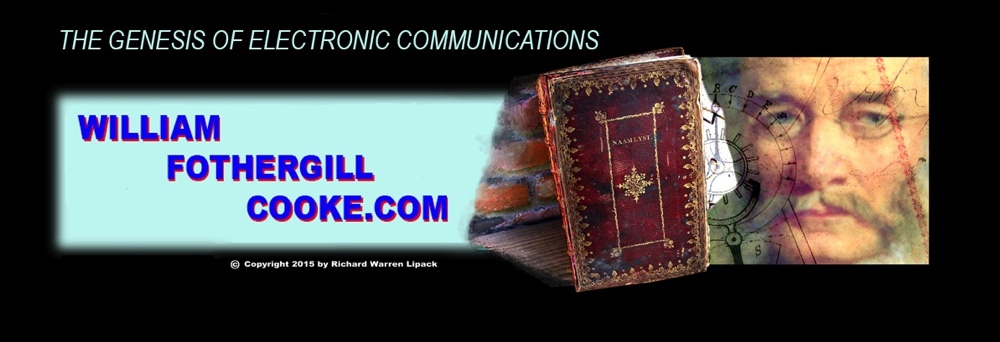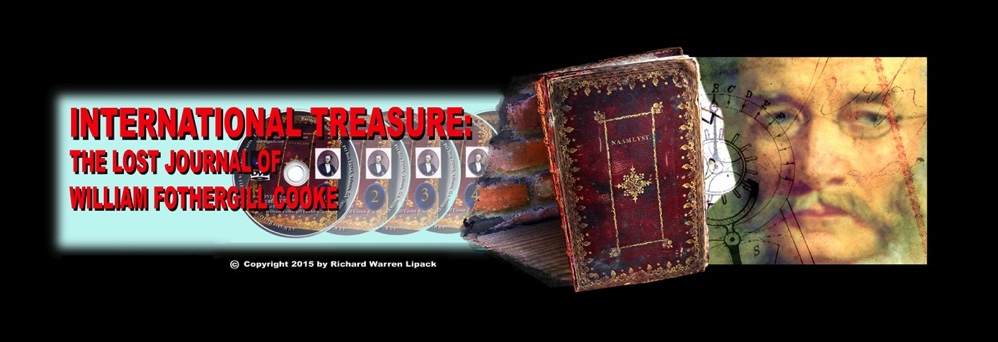

PALEOGRAPHY PROCESS USED TO AUTHENTICATE WM F COOKE TELEGRAPH JOURNAL - PART 5 OF 8
Richard Warren Lipack, the American based international historian, antique artifacts dealer and archivist discovered inventor Cooke's manuscript telegraph builder's journal in the late 1990's in the United States - thousands of miles from where the Cooke Journal was created.
Initially seeking to make contact with the Science Museum in London in 2002 and getting an enthusiastic response from Andrew Nahum - then acting Curator of Communications at the Science Museum - a UK bound trip was planned by Richard Warren Lipack. It looked like the journal of drawings thought to have been executed by the Cooke and Wheatstone partnership's machinist Frederick Kerby would soon be travelling back to England. Today, as of the year 2018, Nahum is Principal Curator of Technology and Engineering at the Science Museum, London.
When initially corresponding with Nathum, this presumption on the part of Richard Warren Lipack that the journal was the work of Kerby was developed owing to the fact the dozens and dozens of the journal pages had the name "F. Kerby" or "F. K." inked on to them above the endless inked drawings found in the telegraph journal.
This assumption was further fueled by references to Frederick Kerby's association with Cooke and Wheatstone made in two books on telegraphy. One reference was found in the 1975 book entitled: Sir Charles Wheatstone FRS, 1802-1875, by former Science Museum Curator of Communications Brian Bowers. The earliest recorded published references to Kerby were found in the 1965 book entitled: Cooke and Wheatstone: And the Invention of the Electric Telegraph by author Geoffrey Hubbard.
To meet with Curator Nathum at the Science Museum, London, air flight and hotel accommodations were booked, but by happenstance, journal discoverer Lipack found out, while searching the Internet, that certain laws existed in England that forbid articles of "National importance" from leaving the country. Thus, as a means to properly safeguard the "Kerby Journal" and its then quite apparent historic contents, historian Lipack cancelled his trip to England to show the journal to the Science Museum. It was feared that upon leaving the country, the journal might actually be seized.
It was known in the antiques trade that there was an incidence where a militaria dealer contacted a curator at a Japanese museum in Japan about two Samuari swords that had belonged once to famous Japanese generals. The flight over to Japan commenced and when the American militaria dealer ravelled with swords in hand to the museum and went to a room to show the two swords, not long after he brought them out for examination by the curator, two heavilly armed Japanese marshals swung open that door and swiftly seized the swords.
The American dealer had no recourse, as he was subject to laws that were under the jurisdiction of the country of Japan. The American dealer lost his property; at the time worth over a half a million dollars!
Thus, it was determined that the "Kerby" journal would remain in the United States, under U.S. law and jurisdiction.
Eventually, John Liffen, a curator taking over the Department of Communications position of Andrew Nahum's at the Science Museum - wrote an email to Richard Warren Lipack in the year 2004 - seeking to know more about the "Kerby journal" and about why the overseas trip to meet with curator Nahum was not made. This led to a series of back and forth emails between Lipack and Liffen, but no serious effort seemingly was made by Liffen to discuss the journal or to come over to the United States to examine the journal..........., or even ask for photographs of sample pages, prior to a possible trip.
Thus, the discussions went nowhere. This frustrated Mr. Lipack, as he was hoping that the Science Museum would have maintained a more scholarly approach with a serious interest. Lipack foolishly assumed that the people at the Science Museum, and especially John Liffen were expert in their profession of preserving history and was hopes that some guidence in lending a scholarly hand to help authenticate or shed more light on the journal would be fostered and forthcoming. But this was not the case.... or so it seemed. A second attempt by Lipack to cause curator LIffen to take a more serous look at the journal was made again five years later, in 2010. But again no serious interest was exhibited.
It was at this point, by January 2011, that historian Lipack decided to start production of a video documentary as a means to authenticate and validate the journal. It was at this juncture in time, as editing of the journal documentary progressed with British born video editor Rpbert Agriopoulos, that the breakthrough in authenticating the journal finally occurred. It was while at editor Agriopoulos's studio in North Carolina.
As producer Lipack looked at a giant video monitor during the editing process, the now hugely blown-up handwriting and Cooke's multiple signatures found on the important July 1840 dated page treating the Blackwall Railway installation - staring Lipack straight in the face larger than life - that it finally became much more apparent that it was in fact Cooke's handwriting and not machinist Frederick Kerby's after all!
Historian Lipack then realized he needed authentic Cooke handwritten letters to compare the journal page entries to in order to properly authenticate the journal. Most amazingly, it came to be that a few very good ones had just become available on the sites of two autograph dealers found on the internet. One was in London and the other was in California. Both were thus secured the next day by historian Lipack and dispatched to his office in Georgia, USA.
Richard Warren Lipack, the American based international historian, antique artifacts dealer and archivist discovered inventor Cooke's manuscript telegraph builder's journal in the late 1990's in America - thousands of miles from where it was created. But it took approximately ten years to finally authenticate that the journal was indeed the the work of William Fothergill Cooke, who, with Professor Charles Wheatstone of King's College, London invented the first perfected commercially based working binary electric telegraph communications system in the world.
The manner with which the journal was authenticated by historian Lipack utilized what is known as the process of paleography. This is a process that consists of comparative analysis of known examples of handwriting called "exemplars" and comparing these exemplars with the handwriting found in the original manuscript one seeks to authenticate. To do this with the Cooke Journal other examples of letters known to be written by Cooke were found as mentioned above and thus, the process was carried out. The results of utilizing the paleography process was successful, This finally occurred in the year 2011. The results are shown and demonstrated in this 5th video of 8 that are being shown on YouTube.
This fifth of the eight video clips shown herein is a sample clip taken from the full 2 1/2 hour video documentary produced and directed by international historian, author and Cooke journal discoverer Richard Warren Lipack.
The full 2 1/2 hour documentary will soon be made available for study along with all pages of the Cooke journal itself through a Premium Content subscription.
IT IS HERE AT WilliamFothergillCooke.com THAT PROFESSORS AND STUDENTS ALIKE CAN BEGIN TO ACHIEVE FULL ACCESS TO ALL OF THE NEW HISTORICAL REVELATIONS & RAMIFICATIONS OF THIS EXCITING NEW SCIENTIFIC DISCOVERY!
INTERNATIONAL TREASURE: THE LOST JOURNAL OF WILLIAM FOTHERGILL COOKE

PART 5
THE GENESIS OF ELECTRONIC COMMUNICATIONS